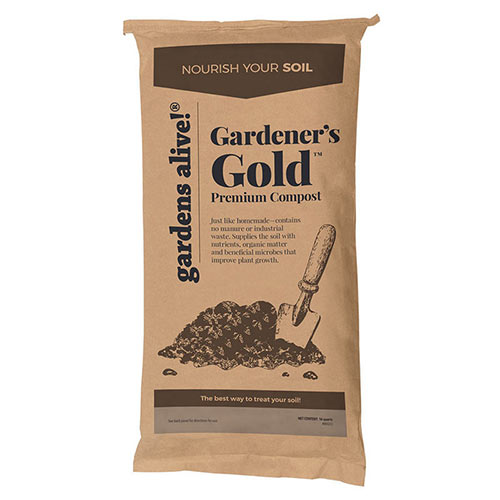An old Avocado Tree in Tennessee and a Troubled Youngster in NJ
-
Helpful Products from Gardens Alive!
-
 Gardener's Gold™ Premium Compost
Gardener's Gold™ Premium Compost -
 Essential Stainless Steel Pruners
Essential Stainless Steel Pruners
Q. Geoff in Kingston Springs Tennessee writes: "My spouse and I inherited an avocado tree from a neighbor that was moving. He started the tree 15 years ago from the pit of an avocado he purchased. It's currently about seven feet tall, with two main trunks and lots of branches and leaves growing off the two trunks. We want to prune it to minimize the height, but do not know the best time to prune and how much. The tree will live in the house during the winter and go out by the pool in the summer. We have managed to keep two plumerias from Hawaii alive in this climate but we don't have any experience with an avocado tree and don't want to lose this plant.We do have grow lights and a sun room ready to assist the avocado if needed."
A. I admire anyone that can keep a tropical tree like the avocado alive and healthy for 15 years, so my first bit of advice is the same as I give anyone in a pass-around-plant situation: If you're still in touch, contact the previous owner and ask how they cared for it. Otherwise, go to the highly informative section of the California Avocado Commission website called "How to Grow Your Own avocado tree". There is an astounding amount of useful information there about outdoor growing (in areas like Southern California) and as a houseplant.
But for pruning details, I called my fruity buddy Lee Reich (author of many books, including "Grow Fruit Naturally" and "THE Pruning Book"). Lee's answer? "you can prune an avocado tree almost any time, but just after midwinter would be best. Prune it more than needed for size control because it will actively grow back from wherever you prune it." Lee adds that it's not hard to keep an avocado tree alive indoors in winter. "But give the tree a summer vacation outdoors in dappled sunlight. Acclimate the plant slowly to the brighter light, temperature changes, and wind of the great outdoors." I'll add that your sunroom sounds like a perfect spot for the winter.
I'll also add to be sure that you never expose the tree to temperatures below freezing, so wait until June to take it outside, and then bring it back inside before you think you have to. But then there's THE obvious question: Is there any chance this tree might produce fruit?
To which Lee responds "I thought you might ask that. It probably won't fruit. It's hard to give it good enough conditions in cold winter areas to get it to flower. And if it does flower, it needs cross-pollination from another variety. And the pollinator has to shed its pollen at the correct time of day. With some varieties that happens in the morning; with others it's at night. Those are two vastly different kinds of pollination.
Lee adds "I've tried all of this. I grafted appropriate varieties onto avocado seedlings that I raised. The plants produced oodles of flowers, but no fruit, even with hand pollination. Best to enjoy it as an attractive houseplant." (For more about Lee's adventures, visit www.leereich.com. )
But again, ask the previous owner: did it ever flower for them? Did they ever see the beginnings of a fruit? The California Avocado Commission notes that most of the flowers fall off without producing fruits, even under ideal conditions. And they warn that once you start pruning, you have to continue on a regular basis.
Q: We move on to another recent avocado question from Riley in New Jersey. "I started growing an avocado plant from a grocery store seed. It was doing well over the summer, but the leaves are now drooping and I'm not sure what to do. The plant is always indoors. Do you have any ideas?"
Again, read the "Growing your own avocado tree" section of the California Avocado Commission's website; it's beyond thorough. Unfortunately, they don't include the symptom of droopy leaves in the houseplant section, but I'll note two possibilities.
Number one is watering. They note that a young tree should be watered frequently; around three times a week. But as the tree gets older, drop back to once a week. Just like me, they advocate a good deep soaking followed by a period of no watering, to allow the roots to dry out periodically. (Root rot seems to be the biggest enemy of farm grown trees in California, including in some notably dry areas.) And because the vast majority of people overwater their plants rather than underwater, I'm going to suggest that might be the cause here.
The avocado pit also needs to be planted high in its soil, with half of the pit above ground (like an amaryllis bulb). The commission recommends that the soil be slightly on the acidic side, with a pH between 6 and 6.5 (7, of course, is neutral). And I'll add that the {quote} 'soil' in any container should be a combination of high-quality organic potting soil and compost; no garden soil.
A. I admire anyone that can keep a tropical tree like the avocado alive and healthy for 15 years, so my first bit of advice is the same as I give anyone in a pass-around-plant situation: If you're still in touch, contact the previous owner and ask how they cared for it. Otherwise, go to the highly informative section of the California Avocado Commission website called "How to Grow Your Own avocado tree". There is an astounding amount of useful information there about outdoor growing (in areas like Southern California) and as a houseplant.
But for pruning details, I called my fruity buddy Lee Reich (author of many books, including "Grow Fruit Naturally" and "THE Pruning Book"). Lee's answer? "you can prune an avocado tree almost any time, but just after midwinter would be best. Prune it more than needed for size control because it will actively grow back from wherever you prune it." Lee adds that it's not hard to keep an avocado tree alive indoors in winter. "But give the tree a summer vacation outdoors in dappled sunlight. Acclimate the plant slowly to the brighter light, temperature changes, and wind of the great outdoors." I'll add that your sunroom sounds like a perfect spot for the winter.
I'll also add to be sure that you never expose the tree to temperatures below freezing, so wait until June to take it outside, and then bring it back inside before you think you have to. But then there's THE obvious question: Is there any chance this tree might produce fruit?
To which Lee responds "I thought you might ask that. It probably won't fruit. It's hard to give it good enough conditions in cold winter areas to get it to flower. And if it does flower, it needs cross-pollination from another variety. And the pollinator has to shed its pollen at the correct time of day. With some varieties that happens in the morning; with others it's at night. Those are two vastly different kinds of pollination.
Lee adds "I've tried all of this. I grafted appropriate varieties onto avocado seedlings that I raised. The plants produced oodles of flowers, but no fruit, even with hand pollination. Best to enjoy it as an attractive houseplant." (For more about Lee's adventures, visit www.leereich.com. )
But again, ask the previous owner: did it ever flower for them? Did they ever see the beginnings of a fruit? The California Avocado Commission notes that most of the flowers fall off without producing fruits, even under ideal conditions. And they warn that once you start pruning, you have to continue on a regular basis.
Q: We move on to another recent avocado question from Riley in New Jersey. "I started growing an avocado plant from a grocery store seed. It was doing well over the summer, but the leaves are now drooping and I'm not sure what to do. The plant is always indoors. Do you have any ideas?"
Again, read the "Growing your own avocado tree" section of the California Avocado Commission's website; it's beyond thorough. Unfortunately, they don't include the symptom of droopy leaves in the houseplant section, but I'll note two possibilities.
Number one is watering. They note that a young tree should be watered frequently; around three times a week. But as the tree gets older, drop back to once a week. Just like me, they advocate a good deep soaking followed by a period of no watering, to allow the roots to dry out periodically. (Root rot seems to be the biggest enemy of farm grown trees in California, including in some notably dry areas.) And because the vast majority of people overwater their plants rather than underwater, I'm going to suggest that might be the cause here.
The avocado pit also needs to be planted high in its soil, with half of the pit above ground (like an amaryllis bulb). The commission recommends that the soil be slightly on the acidic side, with a pH between 6 and 6.5 (7, of course, is neutral). And I'll add that the {quote} 'soil' in any container should be a combination of high-quality organic potting soil and compost; no garden soil.
-
Helpful Products from Gardens Alive!
-
 Gardener's Gold™ Premium Compost
Gardener's Gold™ Premium Compost -
 Essential Stainless Steel Pruners
Essential Stainless Steel Pruners







 Gardens Alive! & Supplies
Gardens Alive! & Supplies




